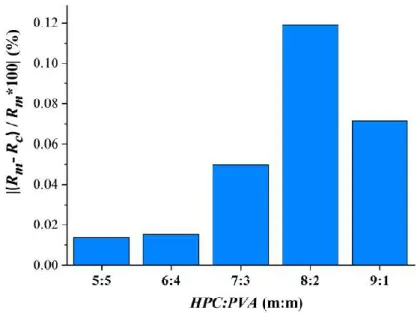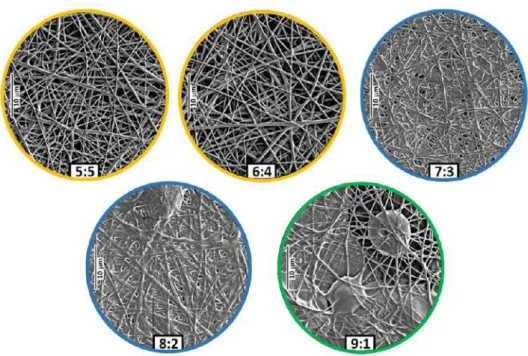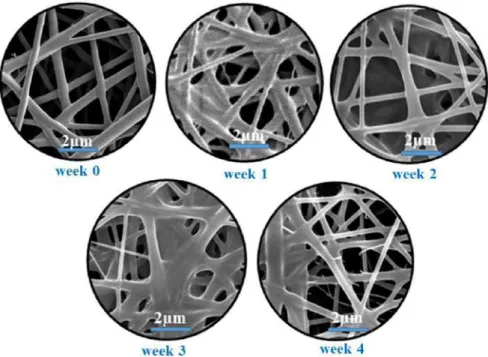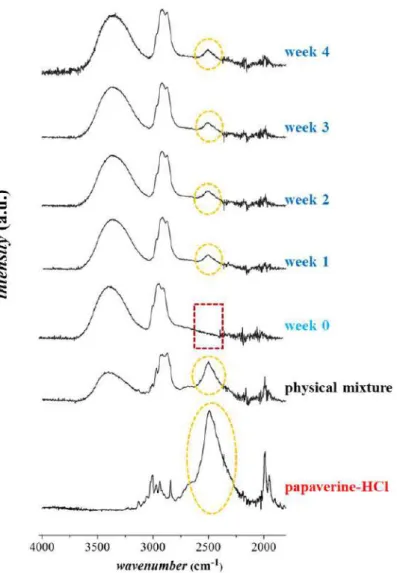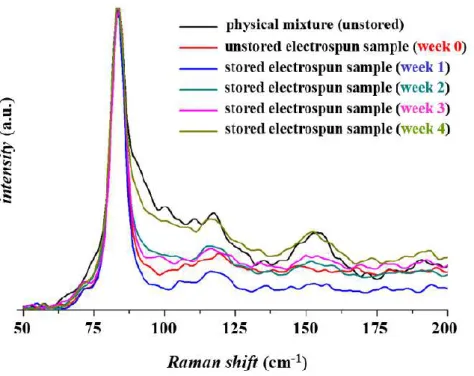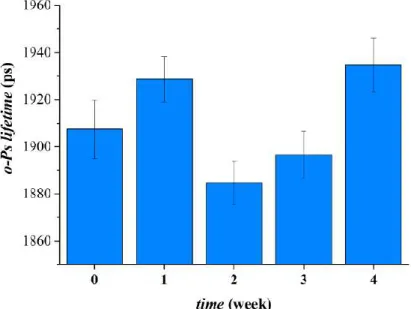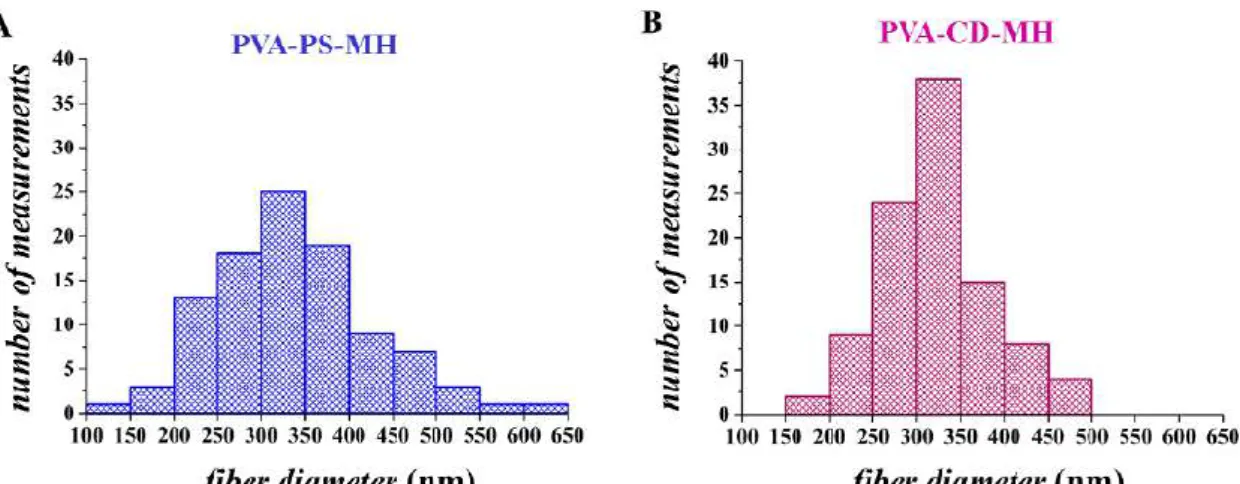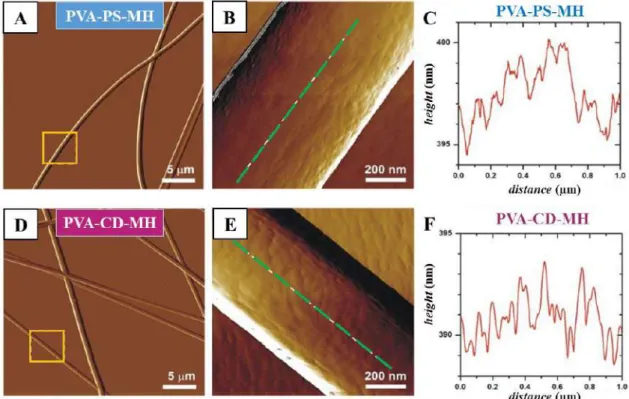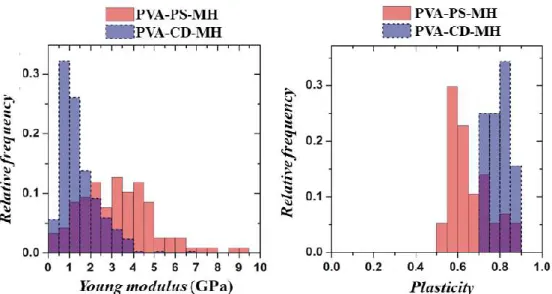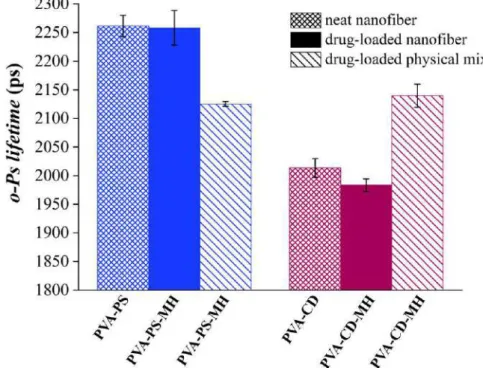SEMMELWEIS EGYETEM DOKTORI ISKOLA
Ph.D. értekezések
2446.
KAZSOKI ADRIENN KATALIN
A gyógyszerészeti kutatások korszerű kutatási irányai című program
Témavezető: Dr. Zelkó Romána, egyetemi tanár Programvezető: Dr. Antal István, egyetemi tanár
FORMULATION AND MICROSTRUCTURAL DISTINCTION OF NANOFIBROUS DRUG
DELIVERY SYSTEMS
Ph.D. thesis
Dr. Adrienn Katalin Kazsoki
Doctoral School of Pharmaceutical Sciences Semmelweis University
Supervisor: Romána Zelkó, D.Sc., professor Official reviewers:
Rita Ambrus, Ph.D., associate professor Krisztina Ludányi, Ph.D., associate professor Head of the Complex Examination Committee:
István Antal, Ph.D., professor
Members of the Complex Examination Committee:
Ildikó Bácskay, Ph.D., associate professor László Tóthfalusi, Ph.D., associate professor
Budapest
2020
TABLE OF CONTENTS
LIST OF ABBREVIATIONS ... 3
1. INTRODUCTION ... 4
1.1. Electrospinning technique ... 4
1.2. Advantages and the related applications of micro- and nanofibrous systems ... 5
1.3. Excipients modifying the drug-loaded fiber characteristics ... 6
1.4. Stability issues of amorphous materials ... 7
1.5. Pharmaceutical application possibilities of nanofibrous systems ... 9
2. OBJECTIVES ... 10
3. RESULTS ... 11
3.1. Preformulation study of papaverine-HCl-loaded samples ... 11
3.1.1. Lorentz-Lorenz analysis of the precursor solutions used for electrospinning ... 11
3.1.2. Rheological investigations of the polymer precursors ... 12
3.1.3. Morphology study of the electrospun samples ... 12
3.2. Solid-state characterization of the papaverine-HCl containing samples ... 14
3.2.1. Results of the FTIR analysis ... 14
3.2.2. Microstructural distinction by PALS measurements ... 16
3.3. Accelerated stability test of the papaverine-HCl containing electrospun sample of HPC:PVA 6:4 mass ratio ... 16
3.3.1. Morphology study of the stored electrospun samples... 16
3.3.2. Micro-and macrostructural investigation of the stored under stress condition ... 17
3.4. Morphology, topography and mechanical properties of the MH-loaded fibrous samples ... 23
3.5. Solid-state characterization of the MH-loaded electrospun samples ... 30
3.6. Stability investigation of the MH-loaded electrospun samples ... 37
3.7. Results of the in vitro study of the MH-loaded electrospun nanofibrous sheets . ... 39
4. DISCUSSIONS ... 42
4.1. Preformulation and characterization of papaverine-HCl-loaded samples ... 42
4.1.1. Preformulation study of papaverine-HCl-loaded samples ... 42
4.1.2. Micro-and macrostructural investigation of the papaverine-HCl
containing samples ... 43
4.1.3. Accelerated stability test ... 43
4.2. Formulation and characterization of MH-loaded electrospun samples ... 44
4.2.1. Morphology and topography of the fibrous samples ... 44
4.2.2. Solid-state characterization of the electrospun samples ... 45
4.2.3. Stability investigation of the MH-loaded electrospun samples ... 46
4.2.4. In vitro study of the MH-loaded electrospun nanofibrous sheets ... 47
5. CONCLUSIONS ... 48
6. SUMMARY ... 51
7. REFERENCES ... 52
8. BIBLIOGRAPHY OF THE CANDIDATE’S PUBLICATIONS ... 63
8.1. Publication relevant to the dissertation ... 63
8.2. Further related publications ... 63
8.3. Other, not related publications ... 64
9. ACKNOWLEDGEMENTS ... 65
LIST OF ABBREVIATIONS API active pharmaceutical ingredients
ASD amorphous solid dispersion
CD cyclodextrin
CP-MAS cross polarization magic angle spinning FTIR Fourier transform infrared spectroscopy
HPC hydroxypropyl cellulose
HP-β-CD hydroxypropyl-beta-cyclodextrin
MH metoclopramide-hydrochloride
o-Ps ortho-positronium
PALS positron annihilation lifetime spectroscopy
PS polysorbate
PVA poly(vinyl alcohol)
RH relative humidity
ROESY rotating-frame nuclear overhauser effect spectroscopy
SD solid dispersion
SEM scanning electron microscopy
SS (ss)NMR
solid solution
(solid-state) nuclear magnetic resonance
t time
XRD powder X-ray diffraction
1. INTRODUCTION
Over the past few decades, nanotechnology has gained increasing attention, which is due to its various fields of applications such as medicine, molecular diagnostics electronics, energy, and environment (1-3). Their potential application as drug delivery, protein- and peptide delivery has become the focus of pharmaceutical research interests.
It is a promising tool for overcoming the formulation problems of drugs of undesirable physicochemical properties (4, 5).
Multifarious nanosized drug delivery systems have been developed, but the significance of the solid lipid matrix-based formulations, inorganic nanoparticles, and the polymeric nanocarrier and nanofibers are the most decisive ones (6). Incorporation of drugs in nanosized systems offer several advantages, for example, the therapeutic efficacy can promote, the drug dissolution and consequently, the bioavailability can improve (6).
Among the polymer-based nanocarriers, the formulation of nanofiber systems has become a very intensively researched field in recent years. Therefore, my thesis focuses on approaches based on the applications of the fibrous materials as drug delivery carriers (7, 8).
Several techniques exist for preparing fibrous materials. Rotary spinning, melt spinning and electrospinning are the most commonly used techniques for fabrication fibers of a monolithic structure. The latter method is able to form a fiber of core-shell structure by using a special coaxial or triaxial emitter (9).
1.1. Electrospinning technique
Electrospinning is a relatively simple, well-established, intensively investigated, and economical fiber fabrication technique, which is able to form continuous fibers in the submicron range under atmospheric pressure and without the use of high temperature, making the formulation of sensitive drugs possible.
Figure 1 Construction of a lab-scale electrospinning device
Figure 1 illustrates the setup of a lab-scale electrospinning device schematically. It has three major parts: the high-voltage power supply, the spinneret (emitter, metallic- needle) and the grounded collector. The emitter is connected to the syringe through a Teflon tube. The prepared precursor (viscous polymer solution or melt) is transferred into a syringe, which is placed in a syringe pump that provides the continuous and controlled flow rate. Fabrication of fibrous materials is carried out by applying high-voltage and is based on the uniaxial stretching of the viscoelastic jet derived from the precursor system (10). During the process, the solvent or solvent mixture evaporates, leaving behind a solid fibrous mesh on the collector. Electrospinning is a continuous method, which makes it suitable for high-volume production. Its popularity is due to the fact that it is a well controllable method for preparing matrices of nano- and micrometer-sizes (11-14). The polymeric fibrous mesh can be prepared from a melt and also from solution precursor systems using an electric field (15-17). The fiber diameters can be controlled well by the process (flow rate, emitter to collector distance, applied voltage) (11, 18, 19) and environmental parameters (temperature, relative humidity) (20, 21, 18) and also by the spinnable precursor physicochemical properties (e.g. molecular weight of the polymer, concentration, surface tension, conductivity, rheological properties) (11, 22, 23, 18, 24- 26). The possibility of fine-tailoring of the fiber characteristics through the optimization of process parameters has been discussed in several research papers (9). The major challenge is associated with the production rate, but its scale-up possibility has been investigated. Despite several solutions and implementations, it is still in its infancy, but due to the improvements, its industrial application is very promising (27-30).
1.2. Advantages and the related applications of micro- and nanofibrous systems There is a wide range of properties of the fibrous materials that can be used in a broad range of biomedical and pharmaceutical applications (9). The unique properties of the random mesh of the nanofibers - high porosity, and the increased surface area to volume ratio - make them attractive as drug delivery vehicles (31). Due to their unique structure, the multifunction property, together with different drugs, can be embedded into nanofibers, and fibers can be prepared from a wide variety of polymers thus modifying the function-related characteristics which are commonly used in tissue regenerations and wound healing (32-35). The latter is based on the features and morphology of the
nanofibrous scaffolds that are very similar to the extracellular matrix, which has a crucial role in wound healing (36). Due to the this structural similarity, the fibrous scaffolds can stimulate cell proliferation and could help the wound healing process (37).
Besides the widespread biomedical applications of the nano- and microfibrous materials, their pharmaceutical applicability has become an intensively researched field.
It has a particular role in the formulation of solid dispersions of drugs with poor water solubility. Solid dispersions are multicomponent solid products, where the active ingredient is embedded into an inert matrix, whose solubility is remarkably improved due to its more favorable wettability and fine particle-size distribution. The grouping of these systems is illustrated in Figure 2.
Figure 2 Grouping of solid dispersions (38)
In pharmaceutical applications, drugs and biologics are usually embedded into a polymer matrix. In the case of poorly water-soluble active ingredients, hydrophilic polymers are the most commonly used matrix. A further advantage of these systems is that with a rational choice of the polymer, the drug release kinetics can be designed to suit therapeutic requirements. The possibilities offered by electrospinning are based on the fact that as a result of the fiber fabrication process, the active pharmaceutical ingredients (APIs) can be embedded into the polymeric carrier in an amorphous state; and the amorphous materials’ energy levels, which are higher than those of crystalline ones, may result in an enhanced apparent aqueous solubility and dissolution rate, and consequently, in increased bioavailability. It should be noted that in addition to amorphous drugs, crystalline APIs and biological materials can also be advantageously embedded in nanofibers (9).
1.3. Excipients modifying the drug-loaded fiber characteristics
There some other approaches in addition to the amorphization; for example, solubility can also be enhanced by using solubilizing agents. The use of surfactants is also providing
a solution for solubilizing lipophilic drugs. Polysorbate (PS) is a universal, non-ionic surfactant, which is widely used in the development of pharmaceutical formulation, as it is capable of improving the aqueous solubility of APIs and also acts as a permeability enhancer (39).
Very popular, but not universal solubilizers are cyclodextrins (CDs) and their derivatives (40, 41). CDs are cyclic oligosaccharides composed of glucopyranose units.
Due to their unique truncated cone structure, hydrophilic exterior surface, and a nonpolar interior cavity (40), they provide drug-complexes of improved solubility properties. As cyclic host molecules with good water-soluble property, they can form inclusion complexes with nonpolar drugs of appropriate size, but besides that, formation of external adducts may also occur. As a result of the complex formation, the physicochemical properties of the drug can be modified. CDs can increase the aqueous solubility of the drug, promote the permeation and absorption of the API across biological membranes, and consequently, improve its bioavailability. They can enhance the physicochemical stability of the drugs via specific, non-covalent bond formations (40, 42). For the fiber formation by electrospinning, the use of uncharged CD derivatives are preferred (43-47), but electrospinning from the charged sulphobutyl-ether-β-CD containing precursor solution has already been described (48). Furthermore, the discussed solubilizing agents can promote the electrospinning process and act as plasticizers. Thus they can modify the mechanical properties of the fibers and enhance the final applicability of the fibrous materials (49).
1.4. Stability issues of amorphous materials
The enhanced apparent aqueous solubility of amorphous materials can be backtracked to their short-range order structural property. Although they have thermodynamically metastable nature (50), these systems are at a higher energy level, which can lead to their spontaneous recrystallization. Their enhanced thermodynamic potential, together with the increased molecular mobility, causes the physical and/or chemical instability of these systems (51). However, the stability and the possibilities for stabilization are a decisive issue for pharmaceutical products, because the product must provide the specified dose in proper quality. Predicting stability and examining the possibilities for stabilization is of huge importance during the formulation process. With the formulation of amorphous
solid dispersions or molecularly dispersed solid solutions, enhanced apparent aqueous solubility can be achieved, and the stability problems can be solved (52-54). Polymer macromolecules are able to form strong intermolecular interactions (e.g., hydrogen bonds) that may also lead to higher physicochemical stability. By a combination of the polymers with other excipients, for example, surfactants that can act as kinetic stabilizers, resulting in third-generation ASDs of improved stability property. Due to the exhibited secondary interactions, a complex molecular structure can be formed, which can reduce the probability of physical state changes of the amorphous API, as a result of the decreased molecular mobility (55).
Besides the embedded amorphous drug, the polymeric carriers are unstable also. Most of the polymers used for fiber formation are in an amorphous state, but if the polymeric carrier has semi-crystalline features that can promote the drug migration to the surface of the fiber, which can easily result in surface-crystallization (6). Aging-related processes can be related not only to the potential transition of the amorphous-crystalline form of the drug, but it can also entail the supramolecular alternations of the polymeric carrier as well.
The long-term stability of polymer-based ASDs is determined by these two phenomena together, because they could affect the release characteristic and kinetics of the embedded drugs, which have a decisive impact on the bioavailability and therapeutic effect (51).
Therefore, great attention should be paid to tracking the solid-state stability and monitoring the supramolecular changes of the drug-loaded nanofibrous mesh, since it is a critical point during the stability of these formulations (56). For investigating the complex micro- and macrostructural alterations, several techniques must be used, which can be classified into three groups: (i) imaging techniques, (ii) macrostructural, and (iii) microstructural characterization methods (56).
In the following, two techniques are discussed in detail. One of them is solid-state nuclear magnetic resonance (ssNMR), which is a very sensitive method, able to verify the nature of the amorphous systems and reveal the plasticizing mechanism. However, with this characterization technique, the free volumes are remaining invisible (57-61). In contrast, positron annihilation lifetime spectroscopy (PALS) is a sensitive method to determine the size distribution of free volume holes through ortho-positronium (o-Ps) lifetime distributions, which is able to follow the physical aging of the polymeric carrier (62-65).
1.5. Pharmaceutical application possibilities of nanofibrous systems
The nanofibrous formulations of required stability and desired function related properties are promising candidates for several dosage forms and pharmaceutical administration. A wide range of polymers can be used for solvent-based electrospinning, but the various polymers have different electrospinnable property. However, the low solubility of the drug in the fiber-forming solution limits the relative amount of drug in the nanofibers, and consequently the mass of the final product, as every polymer has an optimal concentration range where optimal fiber characteristic can be achieved.
Therefore, the nanofiber-based formulations can be a potential product in the case of the API of a lower dose. The prepared nanofiber can be used as a final product, e.g., as buccal or sublingual sheets (66-68), wound bandage (69-72), or as intermediate product. After milling the fibers, an orodispersible (73) or a conventional tablet can be formed, but in the latter case great attention should be paid to monitoring changes in the physical state of the embedded drug(s), because changes may occur as a result of the milling process (74-77). Nanofibrous materials could be promising candidates for various administration routes; besides the most common per os application of the different formulations, the oral cavity is a possible site for the nanofiber-based controlled or fast release drug delivery systems for local therapy of the diseases of the oral cavity (78-80). In the case of this application, the most important factors are residence time and local drug concentration, because these influence the amount of the absorbed drug (81-83). The transmucosal routes offer an excellent alternative for systemic drug delivery of the APIs because of better patient adherence, ease of removal of the dosage form in emergencies, and good accessibility. That is due to the anatomic features of the mucosa: highly vascularized, rich in blood supply, and relatively permeable (84). However, permeation enhancers (e.g. PS, sodium lauryl sulfate, CDs) must be used to achieve the adequate level of bioavailability (85-87). Pharmaceutically luring advantages of the nanofibrous buccal formulations make them a very promising dosage form for diseases where the rapid onset (e.g., pain relief, nausea, migraine) is essential and in the case of APIs owing to the risk of potential liver damage. With nanofibers, the solubility related issue can be solved, whilst with the buccal administration route aims at the concerns associated with hepatic fist-pass metabolism and higher inter- and intraindividual varieties (88-94).
2. OBJECTIVES The main objectives of my work were as follows.
To formulate a papaverine-HCl-loaded nanofibrous sample for further buccal administration. For the bases of the formulation the first generation mucoadhesive hydroxypropyl cellulose (HPC) was chosen, but to improve its electrospinnability poly(vinyl alcohol) (PVA) was added to the system.
To determine the best composition for the fiber fabrication by electrospinning via preformulation study of different HPC-PVA mass ratios. (Besides, the total polymer concentration was kept constant.)
To investigate the effect of rheological properties and intermolecular interactions on morphological characteristics of the fabricated sample.
Supramolecular characterization and physicochemical investigation of the samples.
To examine the physicochemical stability of the drug-loaded nanofibers and to highlight how the physical aging of the polymeric carrier and the solid-state transition of the embedded drug take place.
To prepare antiemetic drug (metoclopramide-HCl (MH) containing, PVA-based nanofibrous buccal sheets via electrospinning by using different permeability enhancer excipients: polysorbate 80 (PS 80) or hydroxypropyl-beta-cyclodextrin (HP-β-CD).
Morphological characterization of the electrospun sample.
To compare the mechanical features of the drug-loaded fibers containing PS 80 or HP-β-CD.
Solid-state characterization of the sample with particular attention paid to the investigation of the physical state of the embedded drug.
To obtain information on the plasticizing effect of the used excipients and to investigate the molecular mobility of the fibrous systems.
To study the dissolution profile of the formulations and to obtain information on drug distribution.
To examine the stress tolerance capacity, especially the supramolecular changing induced by elevated temperature and relative humidity.
3. RESULTS
3.1. Preformulation study of papaverine-HCl-loaded samples
3.1.1. Lorentz-Lorenz analysis of the precursor solutions used for electrospinning Using the measured density and refractive index for precursor solutions of different HPC:PVA mass ratios, the Rm values, and space-filling factors were calculated. As a function of the PVA (as an auxiliary polymer) concentration of the precursor solutions (% w/w), the Rm values were plotted, and the slope of the fitted linear curve was 2.4024, and the linear regression accuracy value (R2) was 0.9999. The Rc values of each viscous solution were calculated based on the linear regression. The space-filling factor were 0.224, 0.223, 0.223, 0.225 and 0.225 for precursor solution of HPC:PVA (m:m) of 5:5, 6:4, 7:3, 8:2 and 9:1, respectively. So a remarkable difference between these values was not found.
Figure 3 Lorentz-Lorenz plot values of papaverine-HCl loaded precursor solutions of different HPC:PVA mass ratios
(Rm is a measured and Rc is a calculated molar refraction index)
Figure 3 represents the Lorentz-Lorenz plot values of the drug-loaded precursor solutions as a function of their HPC:PVA mass ratio. It can be observed that with the increasing HPC ratio, the Rm and Rc values decrease continuously.
3.1.2. Rheological investigations of the polymer precursors
The viscoelasticity of the precursor solutions fundamentally determines the jet formation and stability; thus, it is a very critical parameter for the fiber formation process.
The storage and loss moduli were determined by oscillatory test measurements. The achieved moduli values were compared at different frequency values, but their ratio showed the same tendency; thereby, only the G”/G’ dynamic moduli ratio results relating to 1.995 s-1 value were evaluated after this (Figure 4).
Figure 4 Ratio of loss (G") and storage (G') moduli of papaverine-HCl loaded precursor solutions as a function of HPC:PVA mass ratio (dynamic moduli measured at
a frequency 1.995 Hz)
On the dynamic moduli ratio vs. HPC:PVA mass ration diagram can be seen unambiguously that it has a local minimum at a sample of HPC:PVA=8:2 mass ratio.
With the increasing HPC ratio, the G”/G’ value decrease monotonically, reaching a minimum, and after that, an increase can be observed.
3.1.3. Morphology study of the electrospun samples
The prepared papaverine-HCl-loaded HPC:PVA viscous solutions of constant 15
%(w/w) polymer concentration, but with different polymer ratios were used for the electrospinning process. Each of the five precursor solutions of different polymer compositions was suitable for electrospinning, but with varying degrees of success. The
electrospinning of the precursors resulted in well-defined, round samples on the collector, from where the samples could be easily peeled off. This is particularly advantageous for further processability and also from the point of the final applicability. The composition of HPC:PVA 9:1 was the exception only, where the removal was inhibited by firm adhesion.
Figure 5 SEM images of the papverine-HCl-loaded electrospun samples as a function of HPC:PVA mass ratio 5:5 (A), 6:4 (B), 7:3 (C), 8:2 (D), 9:1 (E)
The morphology of the electrospun samples are shown in Figure 5. With the increasing HPC ratio to PVA morphology changes were obtained; spray-dried film-like structures, fibrous films, and clearly fibrous samples can be observed in the SEM images.
At 9:1 HPC:PVA mass ratio, partial spray-dried film formation, and beaded fiber can be observed (Figure 5E). Electrospinning and electrostatic spraying co-occurred, which resulted in beaded fibers combined with film elements. In the case of 8:2 and 7:3 ratios, fibrous film morphology characteristics were obtained (Figure 5D and C, respectively), but in the latter case, the fibrous structure characterizes the whole fibrous film sample.
SEM images of the electrospun samples of the two lowest (5:5 and 6:4) HPC ratio showed that random orientated, clearly fibrous structure without beads and film-like elements were achieved (Figure 5A and B, respectively).
As the HPC ratio was decreased, the fibrous characteristic became the dominant feature. The transition of a predominantly fibrous system from film formation was initiated at 8:2 HPC:PVA ratio, and was completed by 6:4 ratio. With the decreasing HPC ratio of the precursor solution, the fibrous part of the electrospun samples noticeably increased.
3.2. Solid-state characterization of the papaverine-HCl containing samples 3.2.1. Results of the FTIR analysis
FTIR measurements were carried out with the aim of characterizing the physical state of the API of the electrospun samples. The FTIR spectra of the electrospun samples, the physical mixture, and the solid components of the precursor solution are shown in Figure 6. In the spectra of the papaverine-HCl, the broad band system of the protonated amines can be observed between 2200-2800 cm-1, with a maximum at 2495 cm-1. The medium intensity bands are appearing above 3220 cm-1 are aromatic C-H vibrations, while the peaks at 2967-2840 cm-1 belonging to aliphatic C-H vibrations. The characteristic peak of the model drug between 2200-2800 cm-1 can be observed clearly in the physical mixture. These characteristic peaks were found to be selective, thus able to verify the physical state of the drug. Regardless of the polymer ratios, peaks belonging to the papaverine salt could not be observed.
Figure 6 FTIR spectra of the components, physical mixture of the components and the drug-loaded electrospun sample of different hydroxypropyl cellulose (HPC) :
poly(vinyl alcohol) PVA ratio
3.2.2. Microstructural distinction by PALS measurements
In order to monitor the supramolecular alternations of the electrospun samples and the corresponding physical mixtures, PALS measurements were carried out.
Figure 7 Ortho-positronium (o-Ps) lifetime values of papaverine-HCl loaded electrospun fibrous samples of different HPC:PVA mass ratio and the corresponding
physical mixtures
Figure 7 shows the average discrete o-Ps lifetime values of the nanofibers electrospun from precursors of different HPC:PVA ratios and the corresponding physical mixtures.
(The electrospun sample of HPC:PVA 9:1 ratio was not suitable for this investigation.) For each composition, decreased o-Ps values for electrospun samples can be observed in contrast to the corresponding physical mixtures.
3.3. Accelerated stability test of the papaverine-HCl containing electrospun sample of HPC:PVA 6:4 mass ratio
3.3.1. Morphology study of the stored electrospun samples
The stress induced morphological changes of the fibrous sample of HPC:PVA 6:4 mass ratio were tracked by SEM measurements. The time-dependent morphological changes can be seen unambiguously in the SEM images of the stored samples (Figure 8).
Figure 8 SEM morphology of the freshly prepared (unstored) and the stored papaverine-HCl loaded electrospun sample of HPC:PVA 6:4 (m:m)
Despite that the fibrous structure was basically preserved until the end of the stability test; remarkable structural changes took place. The fibrous structure was deteriorated by the stress conditions in two major steps. Firstly, the merging and broadening of the individual fibers can be observed, and thus the fiber-film like transition was started, which became more pronounced as storage time progressed. Secondly, fragmentation occurred, which was manifested in the formation of tenuous initiative scraps.
3.3.2. Micro-and macrostructural investigation of the stored under stress condition FTIR measurements were carried out with the goal of the monitoring the physical state of the embedded drug. FTIR spectra of papaverine-HCl loaded electrospun samples as a function of storage time can be seen in Figure 9.
Figure 9 FTIR spectra of papaverine-HCl, the physical mixture, the freshly prepared and the stores (week1-4) electrospun sample of HPC:PVA=6:4 (m:m)
On the spectra of the freshly prepared sample, high-intensity selective characteristic peaks related to the API around 2500 cm-1, which belonging to the protonated amine group of the API, could not be observed. Some peaks were merging and broadening, as was expected based on the preliminary study (which was discussed in detail in 3.2.1 chapter).
Unexpectedly, already after one week of storage, the peaks around at 2500 cm-1 appeared, which was possibly related to the API and persisted until the end of the stability test. In the case of all the sampling points, the relative intensity of this peak remained nearly constant.
Raman spectroscopy analysis were performed to monitoring the stress tolerance capacity of the formulation. The vibrational characterization of the samples can be seen in Figure 10 and Figure 11.
Figure 10 Raman spectra of the samples between 400 and 3500 cm-1
Visible characteristic peaks of the API appeared in the spectrum of the physical mixture, which is referred to the crystalline state of the drug. In contrast to the freshly electrospun sample, where the merged spectral pattern could be observed, spectra of the stored samples showed a progressive change until it reached a profile like the physical mixture. Consequently, the crystallization process had a time-dependent nature.
Figure 11 Raman spectra of the samples between 400 and 800 cm-1
The shifting of the peak was notable only in one case; the CH-stretching vibrations of the API around at 2938 cm-1 wavenumber. Along with the storage time, the peak shifts were the following: -4.9 cm-1, -1.9 cm-1, -2.9 cm-1, -2.9 cm-1 and -2.9 cm-1 for week 0, 1, 2, 3, 4, respectively.
Figure 12 The shape of the Raman spectra of the region between 50 and 200 cm-1
After a more thorough examination of the region of 50–200 cm-1 assigned as lattice vibration, a time-dependent process can be inferred related to the solid-state changes of the drug-containing polymeric system (Figure 12).
Figure 13 Integrated area of the Raman peak (at 85 cm-1) of the physical mixture, freshly prepared and stored (weeks 1-4) papaverine-HCl loaded electrospun samples of
HPC:PVA=6:4 mass ratio between
The spectral profile and the integrated area of the region between 50 and 200 cm-1 were becoming more and more similar to the characteristic feature of the physical mixture, which indicated that the amorphous to crystalline transition of the drug took place as a result of the exposition to stress conditions (Figure 13).
It was also observed that the characteristic peaks in the region of 700–780 cm-1 related to the benzene and isoquinoline ring out of plane deformation and the C-C-C bond (which connects the two rings) deformation merged into the baseline, and then along with the storage time, these peaks were re-separated (95).
After a detailed analysis of the spectra in the region of 430–700 cm-1, where peaks of the wagging vibrations of methoxy moieties (463 cm-1 and 473 cm-1), out of plane deformations of the rings (533 cm-1, 563 cm-1), in-plane and out of plane deformations of the rings and twisting vibrations of methoxy moieties (647 and 662 cm-1, respectively) can be noticed (Figure 11) (95).
The aging related microstructural changes of the drug-loaded fibrous sample of HPC:PVA 6:4 mass ratio was detected by PALS measurements. The average discrete o- Ps lifetimes as a function of storage time showed a two-step process of a supramolecular alternation. One week storage in stress conditions resulted in the increase of third-lifetime value and thus larger free volume holes. After that, a sharp drop can be observed, and then a consecutive remarkable increase in o-Ps lifetime values can be noticed.
Figure 14 Average discrete ortho-positronium (o-Ps) lifetimes of the papaverine-HCl
The two-step aging process was obviously detectable in the distribution curves of o- Ps lifetimes (Figure 14), implying multiple supramolecular changes throughout the stability test.
Figure 15 The ortho-positronium (o-Ps) lifetime distributions in the papaverine-HCl- loaded electrospun nanofibers of HPC:PVA=6:4 mass ratio, after 0, 1, 2, 3, 4 weeks of
storage (t0, t1, t2, t3, t4)
A definite change could be observed in the distribution in terms of the width as well in the average values after one week of storage. This process was followed by a second rearrangement, where backward shift and narrowing of the distributions could be noticed unambiguously. With the progressed storage time, the peak at 1.951 ns, indicative of o- Ps atoms shifted towards longer lifetimes (o-Ps=2.038 ns after one week), which referred to the increase of free volume holes in size and could arise as a consequence of the relaxation of the structure (Figure 15).
3.4. Morphology, topography and mechanical properties of the MH-loaded fibrous samples
MH-loaded, aqueous viscous PVA solutions of two different compositions were prepared, and fibrous samples were manufactured with electrospinning. After the optimization of the fiber formation process parameters and compositions of the viscous
solutions for the electrospinning process, well-defined, round-shaped samples were achieved on the collector. Randomly oriented, clear fibrous structure without any beads and film-like areas can be observed in the SEM images of each sample (Figure 16).
Figure 16 SEM photos of the poly(vinyl alcohol)-based, metoclopramide-HCl- loaded electrospun sample either containing polysorbate 80 (PVA-PS-MH) (A, B) or
hydroxypropyl-β-cyclodextrin (PVA-CD-MH) (C, D) (Magnification: 3500× (A, C) and 10000× (B, D)
On the SEM images, clusters or any visible signs of heterogeneity could not be detected in either sample e.g., surface crystallization of the active pharmaceutical ingredient and other artifacts was missing. In the case of the PVA-PS-MH sample, a more densely packed fibrous structure was achieved, while a sparse coverage was obtained for PVA-CD-MH fibers.
Figure 17 Histograms of the fiber diameter distribution of metoclopramide-HCl- loaded electrospun sample either containing polysorbate 80 (PVA-PS-MH) (A) or
hydroxypropyl-β-cyclodextrin (PVA-CD-MH) (B)
336±88 nm and 323±62 nm (mean ±SD) average fiber diameter values were achieved for PVA-PS-MH and PVA-CD-MH electrospun samples, respectively. In the case of the PVA-PS-MH sample, a slightly wider fiber distribution was obtained than that of the PVA-CD-MH fibers with a more uniform structure (Figure 17).
Fiber diameter distributions of the two electrospun samples were investigated using the Kolmogorov–Smirnov test, which indicated that distributions of PVA-PS-MH and PVA-CD-MH fibers were normal (p = 0.844 and 0.416, respectively). A one-way analysis of variance (ANOVA) revealed that no significant difference between the diameter of the two formulations was found (p=0.211).
Figure 18 AFM amplitude-contrast images of poly(vinyl alcohol)-based, metoclopramide-HCl-loaded, either containing polysorbate 80 (PVA-PS-MH) (A, B, C)
or hydroxypropyl-β-cyclodextrin (PVA-CD-MH)(D, E, F) nanofibers.
Panel B and E are higher resolution images of areas indicated by yellow rectangles on panel A and D, respectively. Height sections (C, F) taken alongside the green dashed
line in panel B and E, respectively.
AFM topography of both PVA-PS-MH (Figure 18A and B) and PVA-CD-MH (Figure 18D and E) fibrous sample appeared similar to those seen in SEM images (Figure 16). The PVA-CD-MH fibers appeared as long, curved, continuous, cylinders.
In the case of PVA-PS-MH fibers, some ribbon-like, flat structure can also be observed (see top left and bottom right corners in Figure 18A).
The height of the investigated regions of the fibers varied between 330-360 nm and 300-450 nm for PVA-PS-MH and PVA-CD-MH fibers, respectively. Relatively smooth fiber surface with only a few nm height variations was observed in the case of both MH- loaded nanofibrous formulations. The height profile of PVA-PS-MH fibers (Figure 18C) showed sharper peaks than the cyclodextrin containing ones, which had a more rounded profile plot (Figure 18F), indicating that PVA-PS-MH fibers display a bit coarser surface.
For the investigation of the mechanical properties of the PVA-based nanofibers formulated with different excipients by AFM, 100 nN, 500 nN, 1 µN and 5 µN loads were
applied at well-defined points of the fiber surface, that was pressed and retracted with the AFM tip at a constant 1 µm/s velocity.
Figure 19 Effect of the mechanomanipulation: AFM-amplitude contrast images of metoclopramide-HCl-loaded electrospun fibers either containing polysorbate 80 (PVA- PS-MH) (A) or hydroxypropyl-β-cyclodextrin (PVA-CD-MH) (B) taken after force spectroscopy. The yellow rectangles indicate areas where force maps (10 × 10 force curves) were taken from. The maximum load applied in each region is written next to
the rectangles.
The manipulated area was re-scanned. No noticeable alternations were found in regions loaded with 100 nN forces (Figure 19). At 500 nN load, few small depressions were seen for PVA-CD-MH fibers, while in the case of the PVA-PS-MH sample, no effect was detected.
Nevertheless, in both formulations at 1 µN and 5 µN loads, permanent surface depressions were observed; thus, these forces enabled plastic deformation. Shallower and blurred depressions were obtained in PVA-PS-MH fibers (Figure 19A), while in PVA- CD-MH fibers, those were deeper and had a more definite profile reflecting the shape of AFM tips (Figure 19B).
Figure 20 shows the representative force curves that were taken at different maximum loads.
Figure 20 Representative force curves taken from metoclopramide-HCl-loaded either polysorbate 80 containing (left panels) or hydroxypropyl-β-cyclodextrin containing (right panels) nanofibers at 100 nN (A, B), 500 nN (C, D), 1 µN (E, F), 5 µN (G, H) maximum loads. Horizontal axes show the distance from the fiber surface.
The negative peak in approach curves in case of 100 nN maximum load can refer to a considerable attractive interaction between the fibers and the tip.
At 0 nm distance, where the fiber surface was reached, the force followed an apparent linear increase up to the threshold load (~100 nN), which is a sign of the elastic response.
When the tip was retracted, the force was decreased, and the retraction curve was roughly parallel to the approach curve. Only a minimal hysteresis can be observed between the two curves, suggesting that at this load there was no plastic deformation.
The large negative force peak of the retraction curve is the consequence of the tip-fiber adhesion, and then the force reached 0 as the tip was drawn farther from the fiber surface.
The ascending force region of approach curves was fitted with the Hertz-model of elasticity (96) that adapted to AFM force spectroscopy (Figure 20A and B dotted lines).
According to distributions of Young's modulus calculated from the fits, in both cases apparent normal distribution was achieved, and for PVA-PS-MH and PVA-CD-MH fibers, the mean±SD values were 3.26±1.74 GPa and 1.48±0.90 GPa, respectively (Figure 21A).
Figure 21 Histogram of Young-moduli and plasticity of the metoclopramide-HCl- loaded fibers formed either polysorbate 80 containing (PVA-PS-MH) or hydroxypropyl-
β-cyclodextrin (PVA-CD-MH)
With the increasing loads, the hysteresis area between the approach and the retraction curves was larger, which was referred to as a plastic deformation of the fibers. In the case of the PVA-CD-MH sample, a larger hysteresis area can be observed at each applied load;
thus, this fibrous formulation is more plastic (plasticity distributions at 5 µN load can see in Figure 21B, as it was concluded from Figure 19.
3.5. Solid-state characterization of the MH-loaded electrospun samples
PALS measurements were performed to monitor supramolecular changes through changing of the o-Ps lifetime values of the physical mixtures, electrospun neat- and drug- loaded fibrous samples. The o-Ps lifetimes of the physical mixtures were found to be roughly the same regardless of the used excipients. The o-Ps lifetime values of PS containing nanofibrous samples (PVA-PS and PVA-PS-MH samples) were increased relative to the physical mixture (Figure 22).
Figure 22 Average discrete ortho-positronium (o-Ps) lifetimes of either polysorbate or cyclodextrin containing neat samples, drug-loaded nanofibers, and related physical
mixtures
The presence of the embedded drug does not modify the average free volume holes appreciably and thus the supramolecular structure; while the o-Ps lifetime of PVA-CD and PVA-CD-MH, neat and drug-loaded electrospun samples remarkably decreased compared to the physical mixture. The drug incorporation into the fibers caused a further slight reduction in the third-lifetime value.
Figure 23 FTIR spectra of the solid components (metoclopramide-HCl (MH), poly(vinyl alcohol) (PVA), hydroxypropyl-β-cyclodextrin (HP-β-CD)) and the drug-
loaded polysorbate (PVA-PS-MH) and hydroxypropyl-β-cyclodextrin (HP-β-CD) containing nanofibrous samples and the corresponding physical mixtures
Figure 23 shows the FTIR spectra of the starting materials used for precursor preparation, electrospun samples, and the corresponding physical mixtures. Characteristic peaks relating to the OH- (at 3320-3340 cm-1), NH-(at ~3190 cm-1), CH- (at 2910-2940 cm-1) bending and NH-stretching (at around 2635 cm-1) vibrations of the MH can be observed clearly in the physical mixture. As the other characteristic peaks of MH overlapped with peaks attributed to functional groups of the excipients, the changes of NH signs were evaluated to verify the solid-state transition of the model drug (MH). In the spectra of the fibrous samples, the high-intensity characteristic peaks of the NH- groups disappeared.
Figure 24 Power X-ray patterns of the solid components (metoclopramide-HCl (MH), poly(vinyl alcohol) (PVA), hydroxypropyl-β-cyclodextrin (HP-β-CD)) and the drug-loaded polysorbate (PVA-PS-MH) and hydroxypropyl-β-cyclodextrin (HP-β-CD)
containing nanofibrous samples and the corresponding physical mixtures
Characteristic peaks of the MH and the broad peak of the PVA and CD appeared in the X-ray diffractograms of the physical mixture (Figure 24). While the XRD patterns of the drug-loaded fibrous samples could be characterized by diffuse peaks, high-intensity characteristic peaks relating to the MH did not appear.
The local anesthetic agent lidocaine is a substituted benzamide derivate as the model drug, but its inclusion complexation with HP-β-CD has already been described and widely studied in the literature (97). Due to the structural similarity of the two drugs, interactions between MH and the randomly substituted HP-β-CD at an atomic level was investigated by two dimensional rotating-frame nuclear overhauser effect spectroscopy (2D ROESY) NMR measurement.
Figure 25 Partial 2D ROESY NMR spectrum of metoclopramide-HCl and randomly substituted hydroxypropyl-β-cyclodextrin (HP-β-CD)
Figure 25 represents a partial ROESY spectrum of the MH-HP-β-CD system, where between the aromatic 1H resonances of MH and the inner cavity protons of HP-β-CD (CD-H3 and CD-H5) intense cross-peaks were clearly depicted. Cross-peaks can be observed between the resonances of the aromatic moiety of MH and the hydroxypropyl chains of the CD.
ssNMR measurements were performed with that goal to characterize the PVA-based nanofibrous systems. In the case of the measurement of MH, a well-resolved NMR spectrum typical for crystalline materials built up of small molecules was achieved.
Based on the single pulse experiment with 600 s of recycling delay, all of the resonance could be assigned to one carbon atom. In the crystalline structure, the N-ethyl groups have a different environment; therefore, their signals differ remarkably from those obtained in the solution NMR spectra, allowing them to be differentiated and assigned.
Figure 26 Solid-state NMR spectra of metoclopramide-HCl (MH) and the nanofibers
Signals of the methyl groups at 9.9, and 3.7 ppm were found to be especially sensitive for the detection of the even low ratio of crystalline ordering in the complex matrix systems. The spectra of the electrospun fibrous samples only showed broadened signals in a wide range (Figure 26). The resonance of MH overlapped with the signals of polymeric matrices. The exceptions were only the methyl and some aromatic signals of the model drug. The sharp MH signals of the crystalline materials (that were used for the precursor preparation for the electrospinning process) were merged and broadened in the spectra of the fibrous samples that unequivocally indicate that the MH has no crystalline structure in the fibers.
On the spectra, a slightly shifted signal can be observed instead of the two methyl resonances; thus, the short-range order could be ruled out on an nm scale.
Information can be obtained with the evaluation of the proton environment of the carbon atoms and their mobility by the analysis of the shapes of the CP build-up curves, which are constructed by varying the contact time and plotting signal intensity vs. contact time.
Fitting of the build-up curves by a simplified expression determination of changes in the chemical environment and relaxation of carbons (according to the Equation 2) was possible:
𝑀(𝑡) = 𝜆−1𝑀0[1 − exp (−𝜆𝑡 𝑇⁄ 𝐶𝐻)]exp(− 𝑡 𝑇⁄ 1) (2)
where = 1+(TCH/T1)-(TCH/ T1), M(t) is the magnetization at contact time t, M0 is the initial magnetization, TCH is the time coefficient of the CP (the time it takes for
magnetization to be transferred from 1H to 13C), and T1 is the relaxation time of the carbon in the rotating frame. This equation is valid only in a regime of fast molecular motion, but it qualitatively describes the experimental CP build-up curves and permits a comparison of the fitted parameters.
Figure 27 13C cross-polarization Magic Angle Spinning build-up curve of the metoclopramide-HCl loaded polysorbate (PVA-PS-MH) (A) and hydroxypropyl-β-
cyclodextrin (PVA-CD-MH) (B) containing nanofibers
This equation is valid only for fast molecular motion, but qualitatively describes the experimental CP build-up curves and allows comparison of the fitted parameters (Figure 27).
The more mobile a carbon, the more slowly it relaxes, so the plasticizing effect of the excipients could be efficiently tracked. Because of the numerous overlaps of the signals, only the signal of PVA at 43.3 ppm was analyzed in detail. The resonance (at 75.3 ppm) attributed to the crystalline PVA decreases or even disappears in the plasticized samples (98).
Figure 28 Solid-state NMR spectra of poly(vinyl alcohol) (PVA) and
metoclopramide hydrochloride-loaded, polysorbate 80 containing fibrous sample (PVA- PS-MH)
This effect is clearly observable on the 13C NMR spectra of the PVA-PS-MH sample (Figure 28), but it is not recognizable on the PVA-CD sample, because of the overlapping signals.
The H-bond structure remained unaltered; consequently, the hydrogen environment did not change significantly around the CH2 groups; thus, the TCH parameter did not change remarkably. The H-bonds formed between the adjacent chains exchanged to H- bonds between PVA and plasticizer molecules in the plasticized electrospun PVA-based fibrous samples. The mobility changes are more explicit, so the plasticization effect reflected in the T1rho relaxation parameter is evident (Figure 29). The mobility of PVA chains was found to be similar in both fibrous samples. In the case of the MH-loaded fibrous samples, the chain mobility increased further, indicating that the API also acts as a plasticizer.
Figure 29 Solid-state NMR relaxation times of neat- and MH-loaded polysorbate (PS) or cyclodextrin(CD) containing nanofibrous sample
The amorphous nature of the electrospun PVA-based ASDs was characterized by the sensitive ssNMR method through the tendency of T1rho values. A slight difference was achieved between the T1rho values of the CD containing neat (PVA-CD) and drug-loaded (PVA-CD-MH) samples, while the relaxation time difference was remarkably higher between the PVA-PS and the PVA-PS-MH samples.
3.6. Stability investigation of the MH-loaded electrospun samples
The ASDs, e.g., the polymeric-based amorphous drug-loaded electrospun nanofibrous systems, have a thermodynamically metastable nature, thus achieving long term stability of these systems, their physicochemical stabilization has a great impact and special interest.
Accelerated stability tests of the electrospun samples are described in this chapter. In the case of each formulation, the stress indicated solid-state stability, and supramolecular changes of the stored samples were investigated with image techniques (SEM), macrostructural (DSC, XRD), and microstructural characterization methods (PALS, FTIR).
Figure 30 SEM photos of the stored (1-4 weeks) of the metoclopramide-HCl loaded polysorbate (PVA-PS-MH samples) (A) or hydroxypropyl-β-cyclodextrin (PVA-CD-
MH samples) (B) containing nanofibers
The stress-induced time-dependent morphological changes of the MH-loaded fibrous samples were tracked by SEM measurements, and no remarkable changes in the
morphological features of the electrospun samples have been detected (Figure 30A for PVA-PS-MH and Figure 30B for PVA-CD-MH sample). For either formulation, no fiber-to film transition or fragmentation could be observed. The integrity of the fibrous
structure was maintained for the four weeks of storage. On the images of the oldest PVA-PS-MH sample, slightly merged and broadened fiber segments could be seen.
The macrostructural alterations were monitored by XRD measurements.
Figure 31 Power X-ray patterns of the stored (1-4 weeks) of the metoclopramide- HCl loaded polysorbate (PVA-PS-MH) or hydroxypropyl-β-cyclodextrin (PVA-CD- MH) containing nanofibers and the corresponding freshly prepared physical mixtures
In the course of the storage, no characteristic peaks of the API appeared on the diffractograms of the stored fibrous samples (Figure 31A for PVA-PS-MH and Figure 31B for PVA-CD-MH).
Figure 32 Discrete ortho-positronium (o-Ps) lifetimes of the stored (1-4 weeks) neat- and metoclopramide-HCl loaded polysorbate (PVA-PS and PVA-PS-MH,
respectively) or hydroxypropyl-β-cyclodextrin (PVA-CD and PVA-CD-MH, respectively) containing nanofibers
The PALS method was chosen for tracking the aging-related changes of the polymer- based drug carriers. As the storage proceeded, the observed difference between the o-Ps values of the neat and drug-loaded PS containing stored fibrous samples became slightly larger: 0.046 ns, 0.059 ns, 0.062 ns, and 0.072 ns for week 1, 2, 3 and 4, respectively (Figure 32A). In the case of the HP-β-CD containing PVA-CD and PVA-CD-MH samples, the o-Ps lifetimes and consequently the average free volume holes were found to be nearly the same during the storage period (Figure 32B).
3.7. Results of the in vitro study of the MH-loaded electrospun nanofibrous sheets For the PVA-PS-MH and PVA-CD-MH electrospun samples, 16.45±0.25 % (w/w) and 14.24±0.27 % (w/w) drug content was achieved, respectively.
The MH distributions in the nanofibrous orally dissolving webs and the corresponding physical mixtures, which could be the base of a tablet formulation, were investigated by Raman mapping. As the amorphous form of the API as a pure component was not available for the analysis and the evaluation, thus, to extract the missing amorphous spectral profile of the MH from the polymeric matrices, the MCR-ALS method was applied.
Figure 33 Raman spectra of the crystalline and amorphous metoclopramide-HCl
The Raman spectra of the crystalline form and the amorphous form of the API (as a result of the chemometric analysis) are shown in Figure 33, where the detectable difference between the forms could be tracked. On the spectra of the amorphous reference form, the broadened and merged signals could be seen.
Figure 34 Raman maps of polysorbate (A) and cyclodextrin (B) containing metoclopramide-HCl-loaded fibers and the corresponding physical mixtures (C, D)
The Raman map of the PVA-PS-MH electrospun sample and the corresponding physical mixture can see in Figure 34A and C respectively, while Figure 34B and D represent the maps of the HP-β-CD containing the nanofibrous sample and the corresponding physical mixture. In the case of both nanofibrous samples, the relative MH concentration values were about the same in each sampling point; only a slight difference could be observed, while in the case of the physical mixtures, remarkable MH concentration fluctuation was achieved.
Figure 35 In vitro dissolution test of the metoclopramide-HCl loaded polysorbate (PVA-PS-MH) or hydroxypropyl-β-cyclodextrin (PVA-CD-MH) containing
nanofibrous samples carried out at phosphate
Figure 35 shows the dissolution profile of the MH containing electrospun nanofibrous samples formulated with different excipients. As it is expected based on, e.g., our previously published study (68), rapid and complete in vitro drug release was achieved when the fibrous formulation contained PS. Slightly slower, but also complete dissolution characteristic of the PVA-CD-MH was observed.
4. DISCUSSIONS
4.1. Preformulation and characterization of papaverine-HCl-loaded samples 4.1.1. Preformulation study of papaverine-HCl-loaded samples
Some degree of overlap is required for successful electrospun fiber production.
Optimal entanglement, where the contact between the polymeric chains resulting in a flexible supramolecular structure to the polymer precursor solution, is developed at a given concentration range and manifested in excellent fiber formation properties. If excessive chain entanglement takes place, which hinders the free movement of the polymer chains, the film formation becomes more pronounced instead of the randomly oriented individual fiber formation. The results can be explained by the change of the entanglements of polymeric chains. The reason is to be found in the dependence of the molar reflectance and rheological parameters of the inter- and intrachain interaction of polymers.
The molar reflectance measurements suggest that with the increasing HPC content, the entanglements of the polymer chains became more pronounced, which was disadvantageous from the point of the fiber formation process. From the nearly same space-filling factor values, similar molecular mobility can be inferred. The observed opposite trend in R values (Rm and Rc) and the HPC ratio implies that no specific intermolecular interaction between the polymers was established. Nonetheless, the observed divergence refers to a slight but non-specific intermolecular interaction, e.g., hydrogen bonding or altered chain entanglement, which was the most effective in the case of HPC:PVA 8:2, 9:1 and 7:3 mass ratios.
The smallest moduli ratio entails the most elastic behavior of the composite precursor solution relative to the other solutions of different polymer ratios. This indicated that the overwhelming viscoelasticity of the precursors could be disadvantageous from the point of fiber formation, because the applied electrical forces could not be transferred with adequate efficiency to the viscoelastic elongation of the polymer jets in the course of the electrospinning process. Polymeric precursors of the smallest G”/G’ ratio, so with the most elastic behavior, resulted in film formation, while in the case of the less elastic behavior of the viscous solutions for the electrospinning more fibrous structures were obtained. It can be concluded that for successful fiber formation, the precursor solution
should have viscoelastic nature, on the other hand too high elasticity is unfavorable in this respect.
4.1.2. Micro-and macrostructural investigation of the papaverine-HCl containing samples
The FT-IR results suggest that the papaverine embedded into the fibers in an amorphous state regardless of the two polymer ratios.
According to the PALS results, denser supramolecular structures were formed as a result of the electrospinning process, which was indicated by the decreased o-Ps lifetime values of the electrospun sample of different polymer compositions and manifested in smaller free volume holes.
4.1.3. Accelerated stability test
The merged and broadened FTIR and Raman bands of the fresh sample indicated that the API embedded into the polymeric carrier in an amorphous state. The appearing characteristic peaks in the spectra of the stored samples suggested that the recrystallization of the API took place. The latter fact is in good agreement with the observed phenomenon of the morphological evaluation. It can track back to limited conformational and molecular mobility of the moieties of the crystalline materials, which were manifested in sharp characteristic peaks. In contrast, in an amorphous state, there are numerous allowed conformations, and the energy can be distributed between them and can lead to a merged and broadened spectral profile.
The effects of higher temperature and elevated humidity remarkably affect the molecular mobility and the secondary intermolecular interactions, namely, increasing the former and decreasing the latter. These changes can presumably predispose the ASD for the physical-state modification, and the escalation of the molecular mobility can make a significant contribution to the chances that amorphous APIs start to form crystals.
The preliminary study showed that only weak secondary inter- and intramolecular interactions occurred between the compound of the polymeric system, which also confirms that even a slight temperature rise can be sufficient to destroy or decrease these attractive forces. The established weak secondary interactions were beneficial for fiber formation because, in this case, optimum molecular entanglement was achieved. On the
other hand, these interactions were not strong enough to prevent the increase of the molecular mobility, thus could not able to keep the API in an amorphous state during the stress-induced stability test. It follows that this was a drawback for the solid-state stability.
The observed reduction in the intensity of the lattice vibrations could also be a consequence of the enhanced molecular mobility, which could lead to the recrystallization of the API via enthalpy relaxation.
These observations of the supramolecular characterization may be due to the combined effect of a number of factors, e.g., the phase transition and redistribution of the API, the supramolecular restructuration of polymeric chains and the fragmentation of the fibrous structure. After the first week of storage, as a consequence of the elevated temperature, the molecular mobility of the polymer chains could increase, and thus the original polymeric structure was destroyed, and a new one was created (t1). The prolonged elevated temperature exposure of the fibers resulted in a different structure in the samples, which were stored for 2-4 weeks. The increase in temperature-driven mobility has sufficient force to overpower the intermolecular binding forces. The widening of the size distribution curves of the free volume holes without remarkable shifting towards larger holes (t1-t3) can be inferred that an intermediate structure was achieved. The fourth storage week induced widening of the o-Ps distribution curve, suggesting that a large fraction of “crosslinks” was destroyed by the enhanced molecular mobility, and the recrystallization of the API caused inhomogeneity in free volume hole size distributions.
4.2. Formulation and characterization of MH-loaded electrospun samples 4.2.1. Morphology and topography of the fibrous samples
SEM and AFM images obviously showed that regardless of the used excipient, a clearly fibrous structure with uniform fiber surface was formed. It can be deemed, the PVA is a convenient polymer to be as the base of the matrix and incorporate the MH.
The AFM measurements showed that loaded with relatively low forces (up to 100nN), largely elastic deformation was obtained. The achieved Young-moduli results: 3.26±1.74 GPa and 1.48±0.90 GPa mean±SD values for PVA-PS-MH and PVA-CD-MH fibers, respectively are in good accordance with trifluoroacetate-derived PVA films value of 1.5- 3.75 GPa (99), that can be found in the literature. At this point, it should be mentioned that Young moduli of different PVA polymers that are reported previously vary in a very
broad range (e.g., 6.4 MPa (100) 1.8-4.7 GPa (101), 32.6 GPa (102), 50 GPa (103)), which could be a consequence of the different compositions, preparation techniques and the applied testing methods. When the fibers were subjected to higher loads (up to 5 µN), the resulted deformation was predominantly plastic. From the plasticity values that were calculated from force spectra and from that phenomenon, 500 nN load led to deformation only in PVA-CD-MH fiber. Thus it can be concluded that the PVA-CD-MH fibers are more plastic than the PS containing ones. By and large, the addition of PS80 resulted in two times stiffer, less plastic nanofibers than the use of HP-β-CD.
4.2.2. Solid-state characterization of the electrospun samples
The CP build-up curves indicated that the HP-β-CD behavior was found to be very similar to PVA (Figure 27B), in contrast with the liquid-like behavior of PS80 (Figure 27A) that indicates that HP-β-CD acts as an inner plasticizer, while PS80 acts an outer plasticizer (104).
The third lifetime values of the PALS results also revealed the different plasticizing effect of the used excipients; the ssNMR disclosed mobility and diffusibility differences of the nanofibrous samples (105). The enhanced mobility and diffusibility of the PVA- PS-MH sample caused by the PS80 manifested in the increased o-Ps lifetime value of the fibrous sample related to the physical mixture. The remarkable reduction in o-Ps lifetime values of the HP-β-CD containing electrospun samples, and consequently in the average size of the free volume holes, implied the supramolecular ordering of the polymeric chains, resulting in a more complex molecular packing.
The XRD characteristic of the fibrous samples, together with their FTIR spectra, indicated the absence of a long term order, thus suggested that as a result of the electrospinning process, the MH embedded into the fibers in the amorphous state, regardless of the formulations.
The ssNMR also verified the amorphous state of the API; furthermore, this method was suitable for clarifying the amorphous nature of the active agent. Nonetheless, this piece of information proved to be very useful during the formulation design, as the true solid solutions have thermodynamical stability alone; the nature of the amorphous systems is not widely studied and described in the literature (57, 58). The slight difference between the T1rho relaxation parameters of the neat- and MH-loaded CD containing
formulations implied that the amorphous API in the PVA-CD-MH electrospun sample were molecularly dispersed. In contrast to the observed higher T1rho relaxations difference in the case of the PS containing formulation, indicated that the amorphous drug distributed inhomogeneously in the matrix, which leads to the formation of clusters and amorphous solid dispersions.
The 2D ROESY NMR spectra indicated that the aromatic part of the API is in close proximity to the cavity of the CD, which suggests the formation of the inclusion complex.
The cross-peaks between the hydroxypropyl chains of the CD and the MH shows that external complex formation also took place. From the very complex complexation results obtained in concentrated liquid solution together with that fact that the solvent evaporation during the electrospinning was extremely fast, we can assume that the formed structure probably also remained in the solid-state. In the case of the other formulation, based on the chemical structure of the compounds, only weaker secondary interaction formation is possible. Nonetheless, in both formulations, regardless of the used excipient, the established interactions were able to moderate the molecular mobility and obstruct the enthalpy relaxation. Thus the recrystallization of the amorphous drug could not occur, which may provide a clear explanation for why the MH remained in an amorphous form until the end of the four-week-long accelerated stability test.
4.2.3. Stability investigation of the MH-loaded electrospun samples
The PALS results of the stored samples indicated that the supramolecular structure of the drug-loaded HP-β-CD containing nanofibrous samples did not change remarkably.
This could be attributed to the host-guest complexation and thus the molecular packing enhancer property of the CD. The observed o-Ps values of the stored PVA-PS-MH samples based on established weaker interaction formation ability of this sample, together with that fact that the PS, as a liquid-like plasticizer can migrate in the fiber and could destroy the already formed secondary-bonds was manifested in time-dependent structural changes, which started during the four-week storage period and is likely to become progressively even more pronounced.
